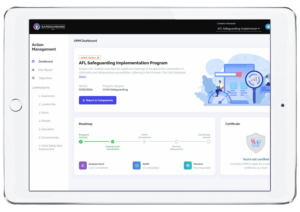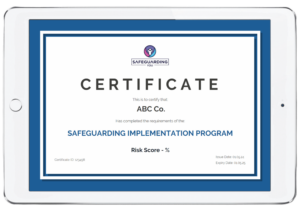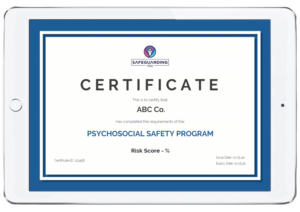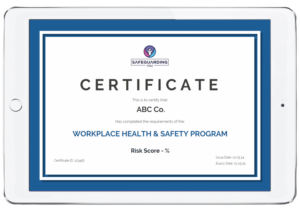Safeguarding Dangerous & Dirty:
Protecting People, Reducing Risks
A safer, healthier, and more productive workplace is just a step away.
Dangerous and dirty industries, including construction, mining, waste management, and manufacturing, are vital to our economy and society. These industries operate in challenging environments, often with high physical demands and complex safety risks. Protecting your workforce while maintaining operational efficiency is essential to success.
At Safeguarding You, we specialise in helping high-risk industries create safer, more compliant, and more supportive workplaces. Our integrated programs for Psychosocial Safety, Human Resources, and Health & Safety provide a comprehensive solution tailored to the unique challenges of dangerous and dirty industries. From worksites to processing plants, we’re here to support your people and your business.
Changing the Face of Safeguarding:
Tailored to High-Risk Environments
Our programs meet the specific challenges of industries where safety and compliance are non-negotiable.
Safeguarding in
One Platform
Manage psychosocial safety, HR compliance, and health & safety seamlessly with ease.
Empowering Carers
and Participants
Our programs help build trust, improve morale, and foster a culture where safety and wellbeing are priorities.
Online + Realtime Programs
Supporting Mental Resilience in High-Risk Environments
Workers in dangerous and dirty industries often face high-pressure environments, long shifts, and exposure to emotionally and physically demanding tasks. The combination of stress, isolation, and fatigue can lead to burnout, mental health challenges, and reduced performance.
Neglecting psychosocial safety not only affects individual employees but also undermines team morale, productivity, and retention. High turnover, absenteeism, and strained relationships can result in operational disruptions, increased costs, and a negative safety culture.
Our psychosocial safety program is designed specifically for high-risk industries, providing tools to identify and mitigate risks, promote resilience, and foster a supportive culture. With tailored training, mental health resources, and practical strategies, Safeguarding You empowers your workforce to thrive in even the most challenging environments.
Building Skilled and Compliant Teams
Managing HR in dangerous and dirty industries involves complex challenges, including recruiting skilled workers, navigating compliance with labour laws, and addressing conflicts in high-stress environments. Without clear policies and efficient HR systems, organisations face inefficiencies, disputes, and potential compliance breaches.
Poor HR management leads to unmotivated teams, unresolved grievances, and staff turnover that disrupts operations. A lack of structured onboarding, training, and performance management creates gaps in skills and accountability, further increasing risks and costs.
Our human resources program equips organisations with tools to streamline HR processes, from recruitment and onboarding to performance management and conflict resolution. We ensure compliance with regulatory requirements while fostering a workplace culture of respect and collaboration. Safeguarding You helps you build a skilled, engaged workforce that supports your business goals.
Protecting Lives in High-Risk Industries
Dangerous and dirty industries operate in environments where safety is non-negotiable. Hazards such as heavy machinery, toxic substances, and physically demanding tasks present daily risks to workers. Without robust health and safety protocols, organisations endanger lives and expose themselves to liability.
A single safety incident can result in serious injuries, fatalities, operational shutdowns, and significant financial and reputational damage. Poor safety measures not only harm individuals but also weaken trust among employees and stakeholders, impacting long-term sustainability.
Our health and safety program is tailored to the unique challenges of high-risk industries. We help organisations implement rigorous safety protocols, train staff on hazard awareness and emergency response, and ensure compliance with workplace safety regulations. By prioritising safety with Safeguarding You, you can protect lives, minimise risks, and maintain operational excellence.
How It Works




These Programs Includes
-
Smart Self Assessment
-
Risk Report: High-Med-Low
-
Action Management Module
-
Incident Management
-
Digital Library of Resources
-
24/7 Access: Mobile & TV
Program Modules
Psychosocial Safety
Implementing a comprehensive anti-bullying policy, training, and a clear reporting system helps prevent workplace bullying, fostering a respectful and safe environment.
Identifying risks and implementing preventative measures, along with clear protocols for incident reporting and management, are crucial in addressing occupational violence and aggression.
Allowing employees to do their jobs from outside the traditional office environment, typically from their homes. It’s about adapting work practices to ensure employees can work safely, efficiently, and effectively from a remote location. This includes providing the right technology, ensuring a safe home workspace, and maintaining good communication and management practices.
Regular assessments of workloads, coupled with feedback systems and adjustments, prevent overwork and stress, contributing to job satisfaction and productivity.
Addressing the emotional aspects of work through support systems and access to mental health resources helps manage the psychological impact on employees.
Designing work schedules that promote work-life balance and prevent fatigue, including flexibility to accommodate personal needs, supports employees’ health and productivity.
Enhancing employees’ autonomy over their tasks and work environment boosts engagement and satisfaction by fostering a sense of ownership and influence.
Managing the psychological impacts of organisational changes through clear communication, involvement, and support minimises stress and promotes adaptability among employees.
Ensuring employees have clear job descriptions and understand their responsibilities reduces ambiguity, improving efficiency and job satisfaction.
Implementing equitable and transparent reward and recognition programs motivates employees and reinforces positive contributions to the organisation.
Leaders promoting a supportive and positive culture contribute significantly to a psychologically safe workplace, enhancing employee well-being.
Effective conflict resolution processes, emphasising fairness and confidentiality, are vital in maintaining a harmonious work environment and positive team dynamics.
Supporting the psychological health of remote and isolated workers through communication and inclusion strategies ensures they remain connected and engaged.
Providing support and resources for employees exposed to traumatic events, including training and a trauma-informed culture, aids in their psychological recovery and resilience.
Human Resources
Understanding and managing the effects and expenses of how you treat your employees and maintain safety in the workplace. It’s about realising how good HR practices and a safe work environment not only benefit employees but also save the business money in the long run, by reducing accidents, improving employee satisfaction, and increasing productivity.
The process of finding and bringing in new staff in a fair, inclusive, and safe way. It’s about making sure the hiring process is free from bias, gives everyone a fair chance, and selects candidates who are not only skilled but also a good fit for the company’s culture and values. This includes considering health and safety aspects, ensuring new hires can work safely, and are aware of safety practices.
The process of introducing new employees to the company. It involves teaching them about the company culture, their role, policies, and especially the health and safety rules they need to follow. This helps new staff understand how to do their jobs well and safely, and makes them feel welcomed and prepared.
The rules and guidelines you set up to manage your employees and ensure a safe working environment. These policies cover everything from hiring practices to how to handle workplace conflicts, and the procedures ensure that health and safety standards are met. They are like a handbook for both employees and managers to know how to act, what to expect, and how to handle different situations at work.
Health & Safety
Taking steps to make sure that employees don’t get hurt on the job. This involves creating a safe work environment, training employees on safety practices, and constantly checking and improving safety measures. It’s about being proactive to identify and fix potential hazards before they cause harm.
Having financial protection in case something goes wrong, like an employee getting injured at work. It’s about the business taking out policies that cover costs related to accidents, injuries, or other workplace issues. This insurance helps the business handle these unexpected events without huge financial strain.
Allowing employees to do their jobs from outside the traditional office environment, typically from their homes. It’s about adapting work practices to ensure employees can work safely, efficiently, and effectively from a remote location. This includes providing the right technology, ensuring a safe home workspace, and maintaining good communication and management practices.
Being prepared to handle unexpected accidents or health issues at work. This includes having first aid kits, trained first aid responders, and clear plans for emergencies like fires or natural disasters. It’s about ensuring that if something goes wrong, there are measures in place to provide immediate help and keep employees safe.
Focusing on the psychological well-being of their employees. It’s about creating a work environment that supports mental health, offering resources like counseling or stress management programs, and ensuring that the workplace culture is open and supportive about mental health issues. This includes addressing factors like workload, work-life balance, and workplace relationships that can affect mental health.
Helping employees come back to work safely and effectively after a period of absence, especially due to illness or injury. It’s about creating a plan that eases them back into their role, maybe with adjusted duties or hours to start with. This process includes working with the employee, their doctors, and possibly other specialists to ensure that their return is manageable and doesn’t risk their health.
Optional Extras... Review & Certify
This Means: Order a Program Review & Receive a Certificate of Assessment



Check Out Our Workplace Relations eBook 👇




